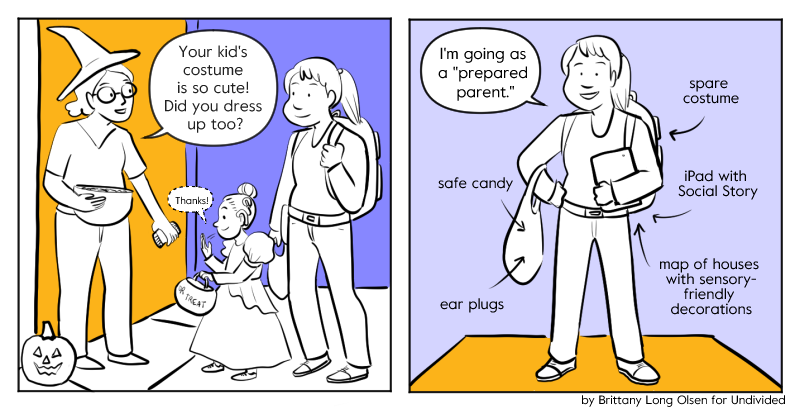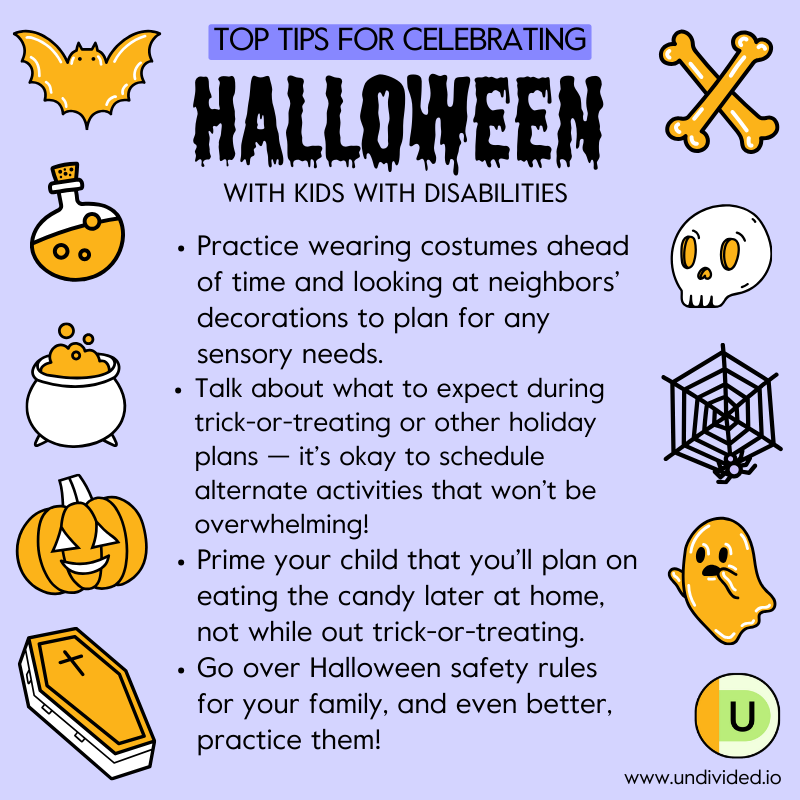Creating a More Inclusive Halloween Experience
Making a more accessible and safe Halloween for trick-or-treaters with disabilities 🎃
For kids with disabilities who may have sensory or socialization challenges, limited diets, sensitivities, or G-tubes, how can we help them enjoy this holiday full of candy, costumes, and spooky decorations? We’ve collected some ideas from our private Facebook group for parents, a behaviorist, an occupational therapist, and plenty of online resources for celebrating Halloween in safe and accessible ways. And stick around to the end because we also have some spooktacular tips from our Undivided Navigators, who are themselves parents raising kids with disabilities!
Managing behavior and creating a safe Halloween experience
Halloween involves a lot of excitement, social interaction with strangers, scary decorations, and trick-or-treating with groups of friends, all of which can be intimidating and spooky for kids. For children with behavioral difficulties who get super excited about the holiday, these difficulties can be exacerbated. On the other hand, some children may not engage in Halloween because it strays from routine or involves activities that don’t hold their interest. Other kids might elope or run off into crowds. For kids with disabilities who have trouble forming meaningful peer relationships, the idea of going solo with family can be crushing.
One way to address worrying or overexcited thoughts in a positive way is to manage expectations. If you’re going trick-or-treating, when can they eat the candy? How long will the trick-or-treating last? Who is going to join? Setting expectations beforehand and being prepared for how the night should go can ease anxieties and unexpected behaviors.
Talk about and practice safety
You can also talk about and practice Halloween safety skills beforehand. For example, you can map out and practice your route ahead of time (and pick a familiar area for them to trick-or-treat in so they feel more comfortable). You can also talk about stranger safety, if appropriate, and help them understand that even though it’s Halloween and we’re interacting with people, the safety rules are still the same. Other things to practice can include staying on the sidewalk, always holding hands with a sibling or buddy, etc.
Lindsay Pineda, M.A., BCBA, and Executive Director of Empowered Behavior Solutions tells us that, “Safety rules always apply, even on Halloween! We may tend to perceive it as if Halloween breaks safety rules — but it does not." Here are a few rules she shares with us that we can share with our kiddos:
- One general rule is to never enter another person’s house by yourself — we don't do that on Halloween either. "Children may get to enter front yards but only because they would be accompanied by a responsible person," she says.
- We may tend to think Halloween breaks the rule of never eating anything a stranger gives you, but we don't break that rule during Halloween either. We still check that any candy can be consumed is safe!
"If there is any other rule that you may think Halloween breaks, then simply emphasize the differences between Halloween interactions with strangers versus everyday interactions." she adds. "For example, if you have used the phrase 'Don’t take candy from strangers,' the difference you would emphasize to your kids is that you are giving them permission to do so because you will be accompanying them (or the responsible person will).”
Prep with Halloween Social Stories
You can prime your child with a Social Story about how trick-or-treating looks and practice ahead of time. Pineda says that parents can even use stories to discuss real versus pretend concepts regarding safety. Here are some sample Halloween stories for ideas:
Plan activities...while being flexible
If you’re worried about a lack of friends, invite another family to join you and explain your plan so that everyone knows what to expect. If going door-to-door causes anxiety, find an alternate activity like a “trunk or treat” to attend. Some organizations (including elementary schools) will put on a Halloween tailgate and decorate the trunks of cars to offer candy, fun decorations, and other goodies in a less stressful environment. Cara L from our parent Facebook group shares, “My son is older now and is excited to decorate his car trunk and hand out candy. It is exciting.”
As Pineda reminds parents, “Halloween is a fun and out-of-the-ordinary activity, so it can get a bit chaotic! Remember to focus on having fun and for your child to have fun as well. It does not matter if your plans don’t get to fruition as long as your child has fun. Be flexible! If you had planned the event and even rehearsed it but your child changed plans last minute, remember to stay calm and be flexible. Your kids’ fun will be your fun, in any way they choose to have it.”
There are many ways to communicate "trick-or-treat!”
Kids may not know they’re getting some extra practice signing or using their AAC device when they go trick-or-treating! These tips also include kids who do not want to make eye contact or say "trick-or-treat" at the door.
- Learn how to sign “Trick or treat!”
- Many AAC programs come with a preloaded Halloween page. If your child’s doesn’t, and you don’t know how to program new words into your kid’s device, there’s still time to ask their speech therapist for help!
- Work together to create and decorate a card that reads “Trick or treat!” for them to hold up.
- Print out a trick-or-treat bracelet they can wear and point to the symbols. Free download here.
- Grab this trick-or-treat bag that also doubles as a communication board. One side says "Trick or Treat" in two different ways using symbols, and the other has a 20-grid communication board to help kids communicate different things while they are trick-or-treating.
- If they want to speak the words but are not easily understood, you can repeat it after them with an affirming high five or praise like “That's great—you said, ‘Trick or treat!’”
- You can also let trusted neighbors know in advance that you’ll be visiting, and be sure to practice with your kiddo before heading out!
Watch this clip for tips from Lindsay Pineda, M.A. and BCBA Executive Director of Empowered Behavior Solutions:
Creating a sensory-friendly and inclusive experience
On average, sensory issues affect one in six children in the United States. Traditional Halloween set-ups and costumes can involve a lot of triggers for children with sensory sensitivities. From fake spider webs, fog machines, and loud noises to itchy, restricting material, the list of causes for a possible sensory meltdown goes on. Priming your child for the Halloween experience can help with this, but many families also create their own way to celebrate to limit sensory overloads.
If you’re concerned about issues when it comes to wearing a costume out to an activity or during a school parade, have your child practice wearing the costume in advance. You can take pictures on a calm day and even have a back-up costume ready. What will make your child excited about dressing up? If this is a simple Halloween T-shirt, then that’s okay!
Preparing for the “scares”
TheraPlay LA founder and CEO Dr. Marielly Mitchell, OTD, OTR/L, SIPT, SWC, tells us that parents can do some things to prepare for the “scares” at events beforehand:
- Look at the available pictures of the event online to help prepare your child for what to expect.
- Try to do a walkthrough of the event prior to opening.
- Some scary mazes/events have ‘no boo’ necklaces that can be worn by anyone who doesn’t want to be scared as a way of indicating to cast members that they shouldn’t jump out at them. Reach out to the event coordinators to ask if this or any other accommodations are available for the event.
- If the event doesn’t provide any accommodations, find videos taken at similar events online. This will allow them to experience this kind of event virtually and help you gauge if it’s a good fit for your child.
- Consider purchasing or bringing noise-canceling headphones or earplugs to reduce the chances of auditory overstimulation.
- If your child has sensitivities to flashing lights or experiences seizures, reach out to the event coordinator to explain your child’s sensitivities and/or health concerns.
Planning your own Halloween event? Here are some more sensory-friendly ideas from Dr. Marielly:
- Allow your child to explore the fully decorated environment prior to guests arriving to allow them to become familiar with their surroundings without the added stress or distractions of other people being present.
- Create a visual schedule for your child to help them anticipate and prepare for the next activity.
- Use the event as an opportunity to expose your kiddo to sensory experiences they don’t typically gravitate towards in a fun, engaging, and non-intimidating way! Have them reach into a bowl of spaghetti ‘worms’ to get a toy eyeball, or hide small toys in slime for them to rescue.
- Make a ‘haunted’ room or maze in your home, avoiding any sudden or loud noises, flashing lights, or strong smells. If your child experiences auditory sensitivities, try to be conscious of the volume of the music and what’s on your playlist.
Getting trick-or-treat ready
When it comes to trick-or-treating, you can also plan ahead. Dr. Marielly tells us, “If possible, walk down the route you’re planning to take alone first to get a sense of how intense the decorations and setups are at each house. This should provide you with a good sense of which houses you may want to skip while trick-or-treating with your little one. Try to avoid houses that are crowded, and limit the number of houses you visit.”
Your child can also help you create an inclusive Halloween experience for the kids who might visit your door! The Perkins School for the Blind recommends making trick-or-treating as accessible as possible: “Clear your walkways of obstacles to make way for individuals who use wheelchairs, walkers, or other mobility devices. And don't forget to illuminate the path with Halloween charm. If accessibility is a challenge, consider setting up a treat station in your driveway to ensure that everyone can partake in the fun.”
Wearing costumes that feel good
Dr. Marielly has some tips for parents when picking out sensory-friendly costumes: “Have your child pick their costume out with you,” she says. “If possible, get one from a store where they can feel the material and fully see the costume prior to committing. Try to select options for your child to choose from that are made from soft, breathable fabrics. Once your child has chosen their favorite costume, wash your child’s costume prior to wearing it (assuming the material is machine washable) in order to get rid of any aversive smells and make it feel more worn. For more plastic-like material or costumes that are not machine washable, consider sizing up so that your child can wear their own clothes underneath.”
If you’re concerned about issues when it comes to wearing a costume out to an activity or during a school parade, have your child practice wearing the costume in advance. You can take pictures on a calm day and even have a back-up costume ready. What will make your child excited about dressing up? If this is a simple Halloween T-shirt, then that’s okay!
Adaptive Halloween costumes
Finding a Halloween costume that meets your child’s unique needs can be challenging in many ways, especially if your child needs a sensory-friendly outfit or wheelchair costume. Check out some of these costumes you can make at home!
While DIYing our kiddos’ costumes can be fun, there are other options out there that are comfortable, accessible, and easy to get on:
- Did you know that there is a company that designs Halloween costumes for kids who are in wheelchairs — free of charge? That’s right — it’s called Magic Wheelchair and they create some epic costumes. To be eligible for a Magic Wheelchair costume, a kiddo must be between the ages of 5 and 17 and primarily use a wheelchair for mobility. A build project timeline averages 8 weeks. Apply for a costume here!
- Rolling Buddies is another company that makes adaptive wheelchair costumes. Check out their costumes here!
- You can also find adaptive Halloween outfits at some of your go-to stores. For example, Target has a line of adaptive Halloween costumes that are generally affordable and have different options for customization.
- If your child is a Disney-fan, Disney’s online store has a range of adaptive, sensory-friendly costumes as well as wheelchair covers and wraps inspired by favorites from Disney, Pixar, Marvel and Star Wars.
“Trick or treat, give me something good to eat!”
For kids with allergies, aversions, sensitivities, and medical issues such as Prader-Willi syndrome, Halloween treats can be the trickiest part. Many candies contain nuts, milk, egg, soy, and/or wheat. Food Allergy Research & Education (FARE) lists seven important candy facts that shouldn’t be forgotten during this spooky season!
- Candy corn contains egg whites and may also have sesame oil. Some chocolates can contain sesame oil as well. According to the recent FASTER Act update to the FDA, sesame oil does not legally have to be included on labels until January 1, 2023. Contact the manufacturer if you have any clarification questions.
- Mini-size candy can have different ingredients than its original-sized counterparts! Be sure to double-check the ingredients to make sure it's safe.
- Manufacturers can change ingredients at any time. Just because certain candies were safe last year doesn’t mean they are this year.
- If you’re not able to identify product ingredients, it may be best to toss or have your child trade you for a safer alternative.
- For those with wheat allergies, licorice typically contains wheat as a binding ingredient.
- While the top 9 allergens (milk, eggs, fish, crustacean shellfish, tree nuts, peanuts, wheat, soybeans, and sesame oil) account for over 90% of allergic reactions, there are 200 reported allergens. There is no such thing as “allergy-free” candy.
- Dark chocolate often contains traces of milk. This may not affect someone with lactose intolerance, but it is considered unsafe for those with a milk allergy.
If you hand out candy or want to give neighbors safe options for your own child, check out these gluten-free candy options, nut-free brands, and dairy-free options. You can also consider non-food items like small toys and trinkets (hint: Target has extremely affordable, adorable, and tiny Halloween bubble wands, squishies, pocket notebooks, spider rings, and more) as suggested by the Teal Pumpkin Project, which hosts an online map every year of houses that offer alternate goodies.
What about handling potentially problematic treats that others may give out to your child? Prime your child that you’ll plan on eating the candy later at home, not while out trick-or-treating. (You can bring along a piece of safe candy in your pocket to keep them going.) Manage the expectation that you will bring candy home and open it in the light.
To remove treats from your home peacefully, some families enjoy traditions like the “Switch Witch,” who trades kids’ candy for other fun surprises (you can modify this idea as you need to). You can also talk to your kids about setting aside candy for others, or participate in a buy-back program for treats at a dentist near you. Here’s a list of ideas to get you started:
- Some Ronald McDonald Houses collect candy for the families staying there during the holiday.
- Several organizations send candy to soldiers stationed overseas, such as Soldiers’ Angels and Operation Shoebox.
- Search Halloween Candy Buyback to find a participating dentist near you!
Celebrating Halloween in your own way
One parent in our Facebook group recommends checking out festive locations like L.A.’s Cemetery Lane at Heritage Square, where there are plenty of things to see and enough distraction that trick-or-treating doesn’t feel mandatory.
You can even opt for a virtual Halloween. The Perkins School for the Blind says, “If the night's excitement feels like too much for your trick- or-treater, respect their preferences and delve into virtual Halloween adventures, dressing up, playing themed games, or entering virtual costume contests from home.”
Do you have any other tips for a fun, inclusive Halloween with your kiddos? We’d love to hear!
Join for free
Save your favorite resources and access a custom Roadmap.
Get StartedAuthor






